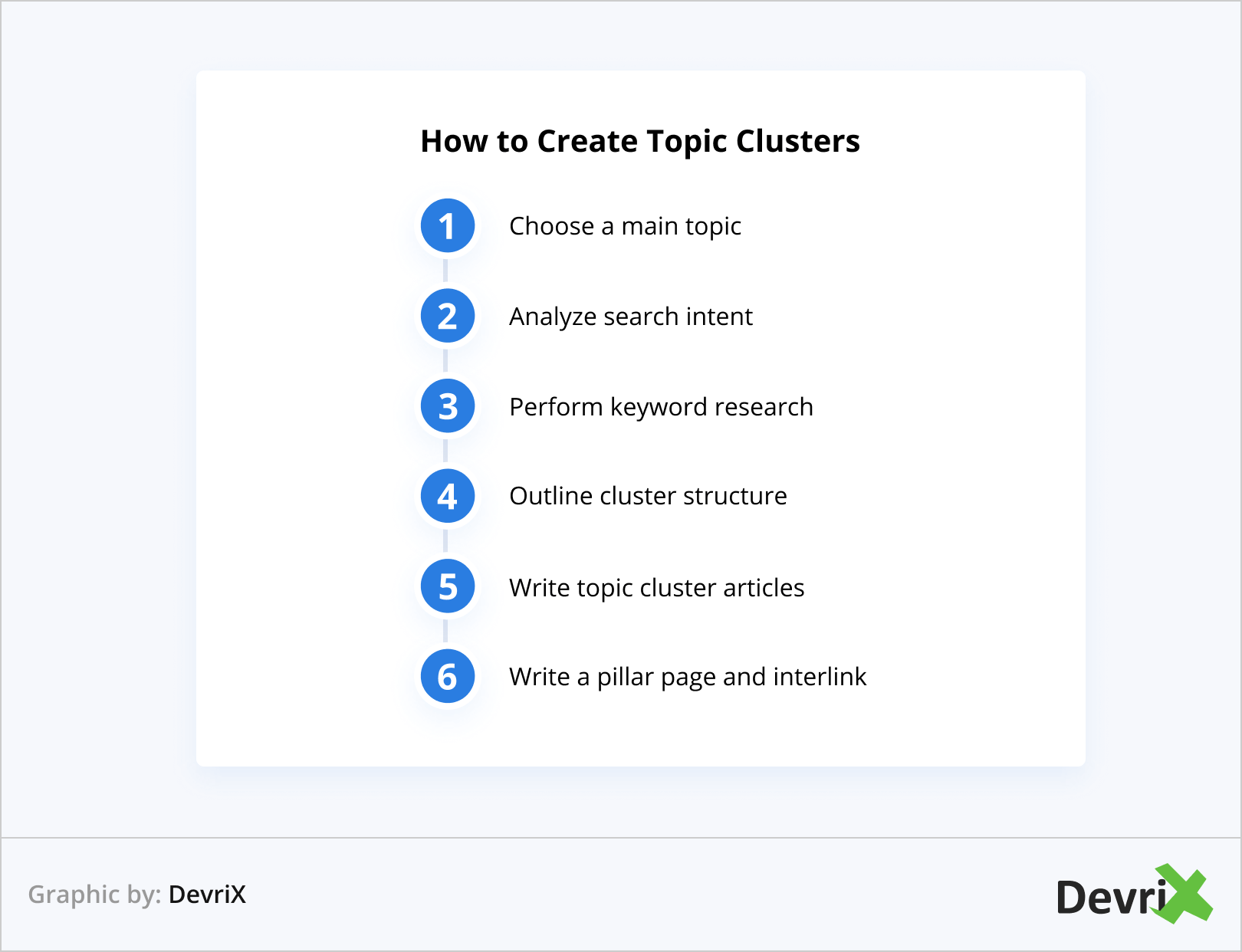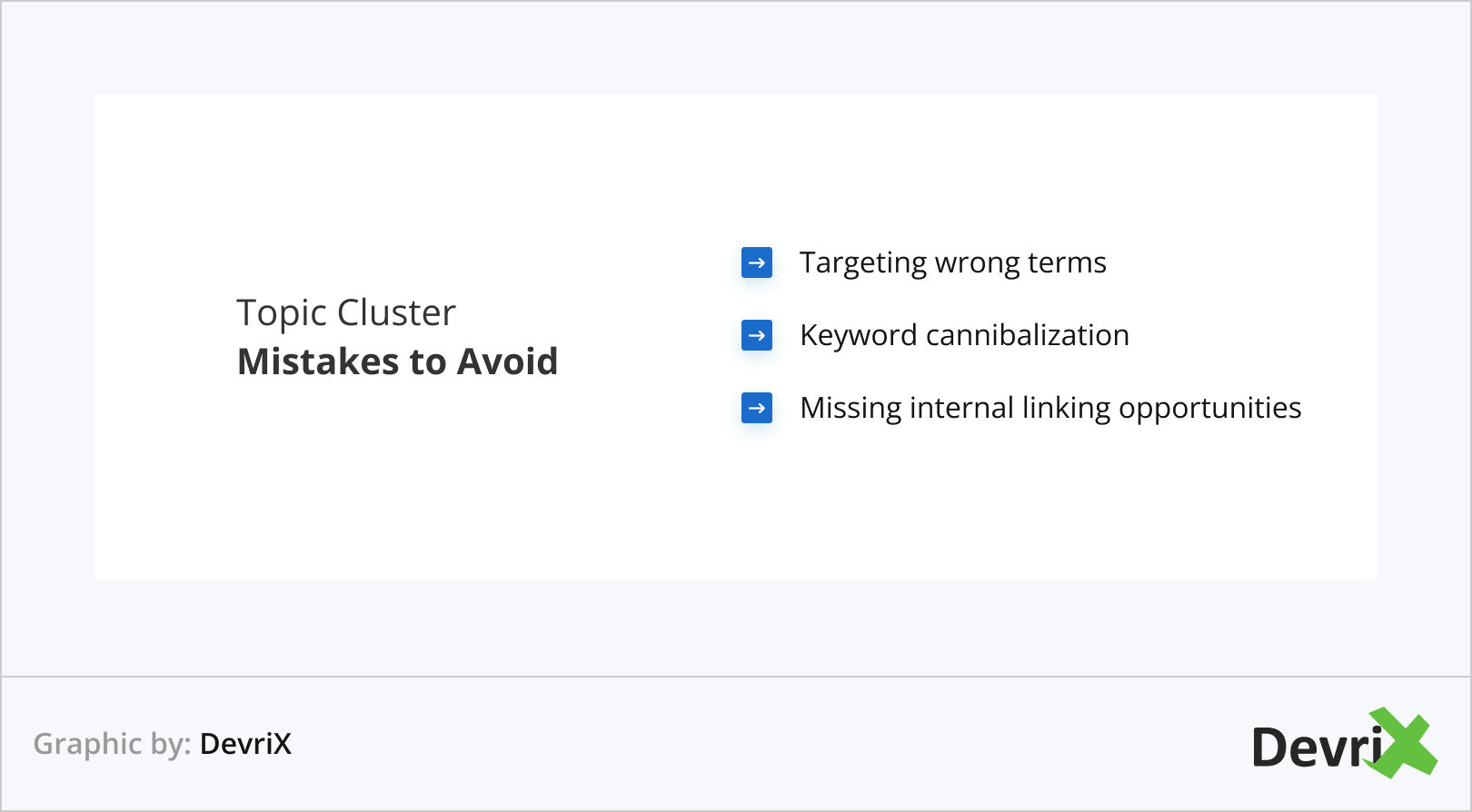Topic clusters have become the main driving force of SEO in the past couple of years. Google started this change back in 2013 with its Hummingbird algorithm update, it was upgraded further with the Rank Brain update in 2015, and since then, search engine optimization has been continually evolving and adapting.
But, hey, it’s okay, if you just heard about this for the first time.
Let’s dig in and find out what topic clusters are all about.
What Are Topic Clusters?
Topic clusters are a group of related articles, or pieces of content, that are all centered around a main topic.
The goal of topic clusters is to deplete a given topic by answering all possible user questions about a specific subject, and to strategically place internal links towards any related articles you have about the subject.
For example, your website is about digital marketing. One of your main categories is SEO. You have written high-quality content about technical SEO, link building, local SEO, backlinks, etc.
Then, at some point, you decide to write a pillar page about SEO, that’s where you can place links to all your other SEO-related articles. Here you can basically create one, single article that broadly covers all the topics, while linking to the other articles, where you cover the specifics.
Ultimately, you present users with a content hub, where they can find all the necessary information about a topic, without having to search for other results on different websites.
What Are the Benefits of Topic Clusters
Pillar pages and topic clusters are very beneficial to your SEO endeavors. Here are four ways they can positively affect your business.

- Enhanced authority. Creating topic clusters is one of the best ways to boost your authority and establish your brand as a trustworthy source of information for the given topic.
- Improved search results. As a result of the topical authority you gain, logically, your search results will be better. Be sure to properly optimize your pillar content for keywords within your niche, so that every related SERP features at least one of your pages in the top 10.
- Increased revenue. A better SERP presence leads to more traffic coming to your website, which could result in increased revenue. Additionally, as topic clusters boost your authority and trustworthiness, users will be more likely to purchase your products, compared to a business that has not yet established itself as an expert in its industry.
- Better UX. Well-written topic clusters will undoubtedly lead to a better user experience on your website since readers will be able to find all the relevant information regarding a topic on your page. This eliminates the need to browse through multiple web pages and keeps visitors engaged on your website for a longer time.
How to Create Topic Clusters
Creating topic clusters is not as hard as you might think. It’s true it takes time to research, strategize, and write, however, the end results will be well worth the time and effort.

- Choose the main topic.
- Analyze search intent.
- Perform keyword research.
- Outline cluster structure.
- Write topic cluster articles.
- Write a pillar page and interlink.
1. Choose the Main Topic
It all starts with selecting the main topic around which you’ll build your topic cluster. Think of topics, not keywords, as you want to own the entire subject, not just single key phrases.
Be sure to select a topic for which your website has the potential to become an industry expert and leader. It would not be wise to write about, for instance, gardening or fashion, when your site is about digital marketing, after all.
Instead, focus on your business-related topic. If you’re a company that focuses on AI software development, you can create a topic cluster about artificial intelligence, machine learning, and so on.
2. Analyze Search Intent
It’s important to analyze user search intent. Focus on determining what questions potential customers might have and how they would search for those possible solutions.
Successfully analyzing and implementing this step can assure your readers will remain on the page longer. Also, do not confuse search intent with keywords.
The user search intent is the reason behind the search, and how people structure their queries – i.e. do they want to know more, are they looking for a direct answer to a question, is there any additional information they want to know after the first query they’ve entered?
3. Perform Keyword Research
Here comes the keyword research part. Ideally, it should be done after determining the search intent. It’s a good practice to group your keywords into sections (if you’re using a spreadsheet) that will allow you to easily match them with their intent.
For instance, you can place the question key phrases at the beginning of your sheet, then have your main keywords at the end, and include LSIs in the middle. Arrange them to your own preferences.
Also, do not forget to include long-tail keywords, as they’re often more important than higher volume, shorter keywords, since a lot of times users clarify their query to find specific information.
Naturally, it’s a good idea to do your keyword research using dedicated tools like Semrush or Ahrefs, but you should also look at Google autocomplete, related searches, people also ask boxes, and featured snippets.
4. Outline Cluster Structure
Audit your already written posts about the topic you’re going to create a cluster about. Group them by subtopics and outline your structure. You can use just a piece of paper or a proper project management tool like Asana, it’s up to you.
The goal of this assignment is to have a view of the bigger picture. This will help you find possible gaps in your topic cluster and ultimately cover all aspects and details of your topic.
5. Write Topic Cluster Articles
At this stage, it’s finally time to sit down and write all your topic cluster articles. There’s no exact number you should go for, it rather depends on your topic and how many articles you would need to write, in order to completely cover the subject.
Write each article, so it’s complete, informative, and presents all the information about the sub-topic. You can also prepare yourself for internal linking by writing appropriate anchor text.
6. Write a Pillar Page and Interlink
You’ve reached the last phase of creating your content cluster. Good job! The only thing left to do now is to write your pillar page and then place strategic internal links to all the related articles you wrote and published.
Let’s take a look at an example. Your topic is “smartwatches”. You write a dozen articles about “best smartwatches for children”, “best smartwatches for men”, “best smartwatches for women”, “best smartwatches for iPhone”, “best smartwatches for android”, “best cheap smartwatches”, and so forth.

Then, you write your pillar page – “best smartwatches”, an all-inclusive list post, where you can easily place links towards all the articles you’ve written about smartwatches. Ultimately, once a user visits your page, they will find extensive information about all kind of smartwatches, and they will not need to visit another website.
Also, pay attention to length. Pillar pages are typically long-form content that vary between 2,000 – 5,000 words. It’s only logical, since, you need to write more, in order to fully cover any given subject.
All in all, this accounts for a good user experience and strengthens your authority on the subject.
Topic Cluster Mistakes to Avoid
There are some common mistakes marketers make when creating topic clusters. Let’s review them.

- Targeting the wrong terms
- Keyword cannibalization
- Missing internal linking opportunities
1. Targeting the Wrong Terms
Sometimes, and often unintentionally, you just opt to target the wrong keywords and phrases. In general, the best practice is to look for broad terms that have a high search volume and high competition.
They also need to be terms where you can delve deeper into subtopics, and not just deplete the subject after writing a few articles. And if you can’t produce enough supporting content for your cluster, it will not reach the designated target.
2. Keyword Cannibalization
This is a trap you can easily for into. Imagine this. You start writing cluster pages, but you optimize all of them around a single set of keywords – small business, for example. So you write articles: “Small business tips for 2022”, “15 small business ideas”, “What is small business”, “How to start a small business”, etc.
In this case, you can quite easily cannibalize your keywords, which will lead to confusion for both Google and users. Additionally, your own pages will be competing against each other in the SERPs, and this will hurt your organic rankings.
3. Missing Internal Linking Opportunities
Proper internal linking between your clusters is an important aspect of SEO that, unfortunately, a lot of marketers fail to do.
Instead, why not use this opportunity to connect your topic clusters so that Google understands the relationship between you and your content? Search engines will be more likely to give you more love once they understand the synergy between the various groups of articles you write.
Summary
Topic clusters are a real game-changer for SEO. Your business will receive a boost in reputation, authority, and trustworthiness based on the successful content clusters you’ve created.
It’s good for everyone – users, your website, Google. Plus, it’s not that hard to create clusters, you just have to research them carefully and establish a clear action plan.
Now go out there and gives those people all the information they need!


![How to Create a Pillar Page [and Its Topic Clusters] in 5 Steps](https://devrix.com/wp-content/uploads/2022/06/How-to-Create-a-Pillar-Page-and-Its-Topic-Clusters-in-5-Steps-380x160.png)

